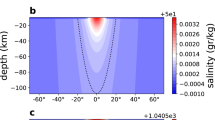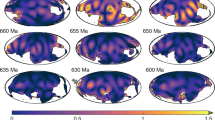Abstract
Geophysical data from the Cassini spacecraft imply the presence of a global ocean underneath the ice shell of Enceladus1, only a few kilometres below the surface in the South Polar Terrain2,3,4. Chemical analyses indicate that the ocean is salty5 and is fed by ongoing hydrothermal activity6,7,8. In order to explain these observations, an abnormally high heat power (>20 billion watts) is required, as well as a mechanism to focus endogenic activity at the south pole9,10. Here, we show that more than 10 GW of heat can be generated by tidal friction inside the unconsolidated rocky core. Water transport in the tidally heated permeable core results in hot narrow upwellings with temperatures exceeding 363 K, characterized by powerful (1–5 GW) hotspots at the seafloor, particularly at the south pole. The release of heat in narrow regions favours intense interaction between water and rock, and the transport of hydrothermal products from the core to the plume sources. We are thus able to explain the main global characteristics of Enceladus: global ocean, strong dissipation, reduced ice-shell thickness at the south pole and seafloor activity. We predict that this endogenic activity can be sustained for tens of millions to billions of years.
This is a preview of subscription content, access via your institution
Access options
Access Nature and 54 other Nature Portfolio journals
Get Nature+, our best-value online-access subscription
$29.99 / 30 days
cancel any time
Subscribe to this journal
Receive 12 digital issues and online access to articles
$119.00 per year
only $9.92 per issue
Buy this article
- Purchase on Springer Link
- Instant access to full article PDF
Prices may be subject to local taxes which are calculated during checkout




Similar content being viewed by others
References
Thomas, P. C. et al. Enceladus’s measured physical libration requires a global subsurface ocean. Icarus 264, 37–47 (2016).
Čadek, O. et al. Enceladus’s internal ocean and ice shell constrained from Cassini gravity, shape, and libration data. Geophys. Res. Lett. 43, 5653–5660 (2016).
Beuthe, M., Rivoldini, A. & Trinh, A. Enceladus’s and Dione’s floating ice shells supported by minimum stress isostasy. Geophys. Res. Lett. 43, 10088–10096 (2016).
Le Gall, A. et al. Thermally anomalous features in the subsurface of Enceladus’s south polar terrain. Nat. Astron 1, 0063 (2017).
Postberg, F. et al. Sodium salts in E-ring ice grains from an ocean below the surface of Enceladus. Nature 459, 1098–1101 (2009).
Hsu, H.-W. et al. Ongoing hydrothermal activities within Enceladus. Nature 519, 207–210 (2015).
Sekine, Y. et al. High-temperature water–rock interactions and hydrothermal environments in the chondrite-like core of Enceladus. Nat. Commun 6, 8604 (2015).
Waite, J. H. et al. Cassini finds molecular hydrogen in the Enceladus plume: evidence for hydrothermal processes. Science 356, 155–159 (2017).
Porco, C. C. et al. Cassini observes the active south pole of Enceladus. Science 311, 1393–1401 (2006).
Spencer, J. R. et al. Cassini encounters Enceladus: background and the discovery of a south polar hot spot. Science 311, 1401–1405 (2006).
Souček, O., Hron, J., Běhounková, M. & Čadek, O. Effect of the tiger stripes on the deformation of Saturn’s moon Enceladus. Geophys. Res. Lett. 43, 7417–7423 (2016).
Běhounková, M., Souček, O., Hron, J. & Čadek, O. Plume activity and tidal deformation on Enceladus influenced by faults and variable ice shell thickness. Astrobiology 17, 941–954 (2017).
McKinnon, W. B. The shape of Enceladus as explained by an irregular core: implications for gravity, libration, and survival of its subsurface ocean. J. Geophys. Res. 118, 1775–1788 (2013).
Monteux, J., Collins, G. S., Tobie, G. & Choblet, G. Consequences of large impacts on Enceladus’ core shape. Icarus. 264, 300–310 (2016).
Neveu, M. & Rhoden, A. R. The origin and evolution of a differentiated Mimas. J. Geophys. Res. 296, 183–196 (2015).
Travis, B. J. & Schubert, G. Keeping Enceladus warm. Icarus 250, 32–42 (2015).
Roberts, J. H. The fluffy core of Enceladus. Icarus 258, 54–66 (2015).
Rollins, K. M., Evans, M. D., Diehl, N. B. & Daily, W. D. Shear modulus and damping relationships for gravels. J. Geotech. Geoenviron. Eng 124, 396–405 (1998).
Hedman, M. M. et al. An observed correlation between plume activity and tidal stresses on Enceladus. Nature 500, 182–184 (2013).
Nimmo, F., Porco, C. C. & Mitchell, C. Tidally modulated eruptions on Enceladus: Cassini ISS observations and models. Astron. J. 148, 46 (2014).
Běhounkovà, M. et al. Timing of water plume eruptions on Enceladus explained by interior viscosity structure. Nat. Geosci 8, 601 (2015).
Monnereau, M. & Dubuffet, F. Is Io’s mantle really molten? Icarus 158, 450–459 (2002).
Soderlund, K. M., Schmidt, B. E., Wicht, J. & Blankenship, D. D. Ocean-driven heating of Europa’s icy shell at low latitudes. Nat. Geosci 7, 16–19 (2014).
Grannan, A. M., Favier, B., Le Bars, M. & Aurnou, J. M. Tidally forced turbulence in planetary interiors. Geophys. J. Int. 208, 1690–1703 (2016).
Lainey, V. et al. New constraints on Saturn’s interior from Cassini astrometric data. Icarus 281, 286–296 (2017).
Fuller, J., Luan, J. & & Quataert, E. Resonance locking as the source of rapid tidal migration in the Jupiter and Saturn moon systems. Mon. Not. R. Astr. Soc. 458, 3867–3879 (2016).
Postberg, F. et al. The E ring in the vicinity of Enceladus. II. Probing the moon’s interior—the composition of E-ring particles. Icarus 193, 438–454 (2008).
Iess, L. et al. The gravity field and interior structure of Enceladus. Science 344, 78–80 (2014).
McKinnon, W. B. Effect of Enceladus’s rapid synchronous spin on interpretation of Cassini gravity. Geophys. Res. Lett. 42, 2137–2143 (2015).
Fountain, A. G. & Walder, J. S. Water flow through temperate glaciers. Rev. Geophys. 36, 299–328 (1998).
Johnson, J. W., Oelkers, E. H. & Helgeson, H. C. SUPCRT92: a software package for calculating the standard molal thermodynamic properties of minerals, gases, aqueous species, and reactions from 1 to 5000 bar and 0 to 1000 °C. Chem. Geol. 18, 899–947 (1992).
Johnson, J. W. & Norton, D. Critical phenomena in hydrothermal systems; state, thermodynamic, electrostatic, and transport properties of H2O in the critical region. Am. J. Sci. 291, 541–648 (1991).
Ishibashi, I. & Zhang, X. Unified dynamic shear moduli and damping ratios of sand and clay. Soils Found. 33, 182–191 (1993).
Fiscina, J. E. et al. Dissipation in quasistatically sheared wet and dry sand under confinement. Phys. Rev. E 86, 020103 (2012).
Wulff, A. M., Hashida, T., Watanabe, K. & Takahashi, H. Attenuation behaviour of tuffaceous sandstone and granite during microfracturing. Geophys. J. Int. 139, 395–409 (1999).
Brennan, A. J., Thusyanthan, N. I. & Madabhushi, S. P. Evaluation of shear modulus and damping in dynamic centrifuge tests. J. Geotech. Geoenviron. Eng 131, 1488–1497 (2005).
Seed, H. B., Wong, R. T., Idriss, I. M. & Tokimatsu, K. Moduli and damping factors for dynamic analyses of cohesionless soils. J. Geotech. Geoenviron. Eng 112, 1016–1032 (1986).
Segatz, M., Spohn, T., Ross, M. N. & Schubert, G. Tidal dissipation, surface heat flow, and figure of viscoelastic models of Io. Icarus 75, 187–206 (1988).
Tobie, G., Mocquet, A. & Sotin, C. Tidal dissipation within large icy satellites: Appli- cations to Europa and Titan. Icarus 177, 534–549 (2005).
Shibuya, S., Mitachi, T., Fukuda, F. & Degoshi, T. Strain rate effects on shear modulus and damping of normally consolidated clay. Geotech. Test. J. 18, 365–375 (1995).
Sun, J. I., Golesorki, R. & Seed, H. B. Dynamic Moduli and Damping Ratios for Cohesive Soils. (Earthquake Engineering Research Center, Univ, California, Berkeley, 1988). Report no. UCB/EERC-88/15.
Araei, A. A., Razeghi, H. R., Tabatabaei, S. H. & Ghalandarzadeh, A. Loading fre- quency effect on stiffness, damping and cyclic strength of modeled rockfill materials. Soil Dyn. Earthq. Eng. 33, 1–18 (2012).
Zhou, W., Chen, Y., Ma, G., Yang, L. & Chang, X. A modified dynamic shear modulus model for rockfill materials under a wide range of shear strain amplitudes. Soil Dyn. Earthq. Eng 92, 229–238 (2017).
Wichtmann, T., Niemunis, A. & Triantafyllidis, T. Strain accumulation in sand due to cyclic loading: drained triaxial tests. Soil Dyn. Earthq. Eng 25, 967–979 (2005).
Raad, L., Minassian, G. H. & Gartin, S. Characterization of saturated granular bases under repeated loads. Transp. Res. Rec. 369, 73–82 (1992).
Faul, U. H. & Jackson, I. The seismological signature of temperature and grain size variations in the upper mantle. Earth Planet. Sci. Lett. 234, 119–134 (2005).
Cole, D. M. A model for the anelastic straining of saline ice subjected to cyclic loading. Phil. Mag. A 72, 231–248 (1995).
Castillo-Rogez, J. C., Efroimsky, M. & Lainey, V. The tidal history of Iapetus: spin dynamics in the light of a refined dissipation model. J. Geophys. Res. 116, E09008 (2011).
Takeushi H., Saito M. in Methods in Computational Physics Vol. 1 (ed. Bolt, B. A.)217–295 (Academic, New York, 1972).
Saito, M. Some problems of static deformation of the Earth. J. Phys. Earth 22, 123–140 (1974).
Ricard, Y. in Mantle Dynamics. Treatise on Geophysics Vol. 7 (ed. Schubert, G.) 23–71 (Elsevier, Amsterdam, The Netherlands, 2015).
Kalousová, K., Souček, O., Tobie, G., Choblet, G. & Čadek, O. Ice melting and down- ward transport of meltwater by two-phase flow in Europa’s ice shell. J. Geophys. Res. 119, 532–549 (2014).
Palme, H. & O’Neill, H. S. C. in Mantle and Core. Treatise on Geochemistry Vol. 2 (ed. Carlson, R. W.) 1–38 (Elsevier, Amsterdam, The Netherlands, 2003).
Choblet, G. Modelling thermal convection with large viscosity gradients in one block of the cubed sphere. J. Comput. Phys. 205, 269–291 (2005).
Choblet, G., Čadek, O., Couturier, F. & Dumoulin, C. ŒDIPUS: a new tool to study the dynamics of planetary interiors. Geophys. J. Int 170, 9–30 (2007).
Goodman, J. C., Collins, G. C., Marshall, J. & Pierrehumbert, R. T. Hydrothermal plume dynamics on Europa: implications for chaos formation. J. Geophys. Res. 109, E03008 (2004).
Goodman, J. C. & Lenferink, E. Numerical simulations of marine hydrothermal plumes for Europa and other icy worlds. Icarus 221, 970–983 (2012).
Acknowledgements
The research leading to these results received financial support from the CNRS PICS (G.C., G.T.), the CNRS-INSU PNP program (G.C., G.T.) and the ANR OASIS project (G.C., G.T.), from the Czech Science Foundation project 15-14263Y (OS), from the German Research Foundation DFG projects PO 1015/2-1, /3-1, /4-1 (F.P.) and from the Icy Worlds node of NASA’s Astrobiology Institute 13-NAI7-0024 (C.S.). The computations were carried out using CCIPL computational facilities (France).
Author information
Authors and Affiliations
Contributions
All authors contributed to the discussions and commented on the manuscript. G.C. and G.T. led the writing of the letter. C.S. performed calculations on core porosity. G.T. computed the tidal dissipation in the porous core. G.C. developed the 3D code of porous water flow and conducted the numerical simulations of porous convection. All authors contributed to the interpretation of results.
Corresponding author
Ethics declarations
Competing Interests
The authors declare no competing financial interests.
Additional information
Publisher’s note: Springer Nature remains neutral with regard to jurisdictional claims in published maps and institutional affiliations.
Electronic supplementary material
Supplementary Information
Supplementary Sections 1–2, Supplementary References, Supplementary Tables 1–4, and Supplementary Figures 1–9
Rights and permissions
About this article
Cite this article
Choblet, G., Tobie, G., Sotin, C. et al. Powering prolonged hydrothermal activity inside Enceladus. Nat Astron 1, 841–847 (2017). https://doi.org/10.1038/s41550-017-0289-8
Received:
Accepted:
Published:
Issue Date:
DOI: https://doi.org/10.1038/s41550-017-0289-8
This article is cited by
-
A recently formed ocean inside Saturn’s moon Mimas
Nature (2024)
-
Detection of phosphates originating from Enceladus’s ocean
Nature (2023)
-
Sustained and comparative habitability beyond Earth
Nature Astronomy (2023)
-
Particle entrainment and rotating convection in Enceladus’ ocean
Communications Earth & Environment (2023)
-
Origin and Evolution of Enceladus’s Tidal Dissipation
Space Science Reviews (2023)



